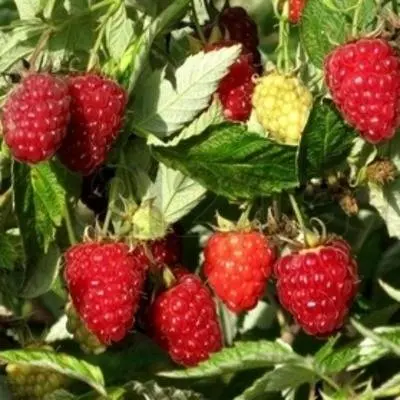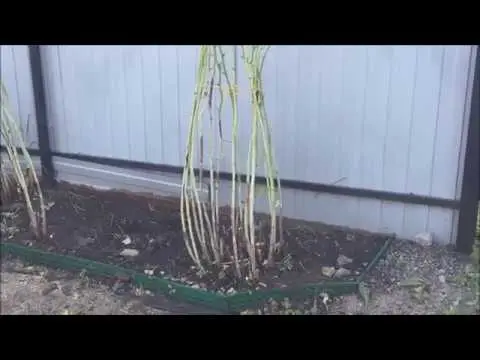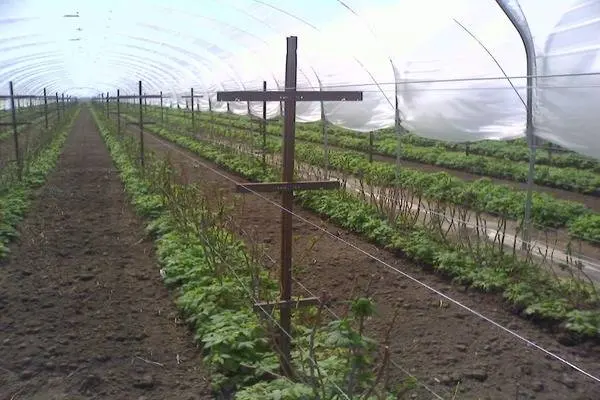Contents
As a rule, summer residents simultaneously grow several varieties of raspberries. Large-fruited raspberries of the Arbat variety with a yield and size of berries can surprise even experienced gardeners.
Characteristic of the variety
Raspberry bushes Arbat grow 1,5-2,0 m high, formed by powerful annual shoots. The stems are characterized by medium internodes (length 3-5 cm), at the ends they become rather thin, without pubescence, do not have thorns. About 17 berries are tied on fruit twigs of medium length. Summer residents note that Arbat raspberry leaves look very decorative. The foliage on the bushes has a corrugated surface with barbed edges.
Among other varieties, Arbat stands out for the size of the berry, which has an elongated conical shape – large raspberries weigh up to 12 g. The berries are notable for their rich dark red color (photo).

Raspberries are easily removed from the stalk and perfectly endure long-term transportation. The pulp of the berry is sweet and juicy. Raspberries of the Arbat variety are magnificent in any form: fresh, boiled or dried.
Bushes winter well with low frosts. In regions with very low temperatures, it is recommended to bend down the stems for the winter. The resistance of the Arbat variety to the defeat of the main diseases is noted. Raspberry Arbat begins to bear fruit in the second half of June and ends in August. With good care, it is easy to harvest 4-5 times per season.
The yield of raspberry variety Arbat is excellent, it is possible to remove 4-5 kg of berries from one bush, and annually.

Raspberry breeding
When growing Arbat, the most time is taken up by caring for the bushes in spring and autumn. The large-fruited variety Arbat is demanding for care. Spring is the optimal period for arranging raspberries. When planting a crop, special attention should be paid to several points:
- seedling quality. Raspberry stems of the Arbat variety with open roots should be without leaves and shortened to about 40 cm. Seedlings are suitable for planting, not damaged or withered, in which the stem has a thickness of at least 0,8-1 cm;
- Raspberry Arbat is planted on a site with moist, loamy or sandy soils. It is recommended to choose a place where the seedlings will be protected from drafts and well lit;
The soil must be well fertilized before planting. It is desirable that it is easy to carry out regular watering of the Arbat raspberry.

Planting of seedlings
Raspberries should not be planted among fruit trees or between vegetable beds. It is recommended to avoid neighborhood with strawberries, tomatoes or potatoes, because pests of these crops can harm seedlings.
Raspberries of the Arbat variety do not like stagnant water, so low-lying places are not suitable for planting a crop. Before planting, the earth is carefully weeded.
Landing steps:
- A ditch is dug, about 40-45 cm wide, up to 30 cm deep. Peat, humus, compost, and rotted sawdust are poured onto the bottom. Separate layers are sprinkled with soil. At this stage, you can enrich the soil with inorganic fertilizers. Based on one Arbat raspberry bush, they take 150-200 g of superphosphate, 50-80 g of potassium sulfide.
- The seedlings are lowered into the ditch, the root system is carefully straightened. It is recommended to place 2 seedlings in each seat. The stems are covered with earth, and they make sure that the basal collars remain above the soil surface.
- A distance of about 50 cm is left between the seedlings, and the row spacing is made at least 150 cm wide. All rows are well watered.
If raspberries are planted in the spring, then the site is prepared and fertilized in the fall. And during the autumn planting, it is recommended to prepare the soil earlier in a month and a half.

How to water
Raspberries of the Arbat variety belong to moisture-loving crops, but raspberries cannot simply be poured with water. The bulk of the roots of the plant is close enough to the surface of the earth (at a depth of 20-30 cm and within a radius of 30-55 cm from the rod). On light soils, the roots can germinate to a depth of up to a meter, and on dense clay soils, only up to 50-60 cm.
After watering, the soil must be loosened to prevent the soil from drying out quickly.
At the end of May, before watering, extra replacement shoots are removed (no more than 10-15 stems are left in the bush). Most of all, raspberries of the Arbat variety need watering in the hot summer months (during flowering, setting and ripening of berries), and towards the end of the season, watering is significantly reduced.
The most common two ways of watering raspberries:
- sprinkling is done with a hose and is popular. To do this, sprinkler systems are installed on a flat, well-ventilated area. A feature of the method is that for high-quality irrigation, a high water pressure is required. Turn on the settings in the early morning or evening when the heat subsides;
- for irrigation through the furrows, grooves are first made along the rows of raspberries of the Arbat variety 10-15 cm deep, at a distance of 35-40 cm from the stems. Water is let through these grooves with a little pressure so that it has time to be absorbed. After watering, the grooves are covered with soil and loosened.
The last watering can be done in November (if there is no rain).
Top dressing of plants
At the beginning of the season, as a rule, nitrogen fertilizers are used, and at the end – phosphorus-potassium fertilizers. A common scheme: inorganics are used every year, and organics are used every other season. Many experienced gardeners recommend fertilizing the soil three times a season:
- in May, a mullein solution is used: 10 ml of fertilizer is taken per 500 liters of water. Top dressing (at the rate of 5 liters per meter of row) is best applied to the soil during irrigation;
- in the first days of July, during the beginning of the fruiting of the Arbat raspberry variety, the Ideal preparation can be used. To prepare the solution, you need 10 liters of water and 2-3 tbsp. l composition. You can also add 2 tbsp. l nitrophoska. This solution is applied at the rate of 7 liters per meter of the Arbat raspberry row;
- in August, as a top dressing, you can use a solution of 2 tbsp. l potassium sulfate in 10 l of water. Fertilizers are applied in the same way as the second time.
Bush care
In order to collect consistently high yields, it is advisable to tie up Arbat raspberry stems. To do this, trellises are equipped along the rows: along the edges of the rows, supports about 160-175 cm high are dug in and parallel lines of wire are pulled between them (through 40-50 cm).

For the proper development of the bushes, they are pruned several times a season:
- in early spring, overwintered stems are examined and dry or damaged rods are cut out. Of the remaining stems, the strongest and most powerful are selected (calculated as 15-18 per meter of row), the rest are also cut out. In case of damage to the top of the stem (it could freeze in winter), it is cut off to a healthy bud;
- at the end of May, the excess shoots of the Arbat raspberry are eliminated, leaving only replacement shoots (it is enough to keep 35-40 pieces per meter of row). As soon as the stems grow to a height of 50-60 cm, it is recommended to fix them on the trellis;
- throughout the season, it is necessary to monitor the spread of the Arbat raspberry in breadth, although this variety is not prone to growth.
Raspberry variety Arbat usually winters painlessly. But this does not apply to regions where frost is below -30˚ C. In areas with very cold winters, raspberries are picked up. To do this, the bushes at the end of September (when the stems are still flexible) are gently tilted to the ground and tied to each other. To fix the plants, they are pinned to the soil. When snow falls, it naturally covers the raspberries.
Pest Control
Throughout the season, it is necessary to pay attention to the condition of the stems and leaves of the Arbat raspberry variety. In the absence of proper care, the raspberry tree can quickly wither and be damaged by harmful insects:
- the raspberry beetle hibernates in the ground. A small, grayish-brown insect destroys flowers, buds, leaves, which leads to a significant reduction in yield. If extensive damage to the bushes is noticed, the plants are sprayed with Karbofos (90 g of the drug is dissolved in a bucket of water). Prevention: thinning of overgrown bushes, treatment of plants in early spring with Bordeaux liquid;
- the spider mite settles on the wrong side of the leaf plate and feeds on plant sap. Favorable conditions for the growth of the number of insects are a long dry period. Before flowering, you can spray the raspberries with Aktellik 500 EU acaricide. As a preventive measure, it is recommended to spray the bushes with water in dry weather.
Malina Arbat during the season requires attention. But in gratitude for good care, the summer resident always receives a bountiful harvest of berries.









